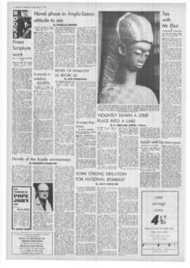Page 4, 12th May 1967
Page 4

Report an error
Noticed an error on this page?If you've noticed an error in this article please click here to report it.
Tags
Share
Related articles
Liverpool Has A Week Of Celebrations
The Memory Man
Whilefrittrs Mis (ic&
Liverpool Cathedral Revisited On Its Tenth Anniversary
The Diary Of A Cathedral
A CATHEDRAL FOR OUR TIME
CARDINAL HEENAN looks back at old plans and discusses the triumph of the present
ARCHBISHOP
DOWNEY'S slogan "a cathedral in our time" captured the mood of his priests and people in 1928. Liverpool had always felt the shame of being the centre of the greatest Catholic community in the land while having no central symbol of authority.
as pro-cathedral, beloved as it was and remains, was a parish church of no great distinction. There was no church in Liverpool worthy of a really great liturgical occasion.
When the Liverpool Catholics had reason for celebration they used to contrive a cathedral in the open air. They were therefore in hearty agreement with their Archbishop when he decided to make the building of a cathedral the goal of his pontificate. It is worth adding that the personal loyalty of the Liverpool clergy and faithful to their archbishop has always been so intense as to astonish outsiders. This made the task of Archbishop Downey's successors comparatively easy when they faced the problem of providing a cathedral in times much Changed from those in which his slogan was coined.
Archbishop Keating was the first to propose the building Of a cathedral on the present scale. In 1921 he suggested that it should be a memorial to his much beloved predecessor, Archbishop Whiteside, under the very suitable title of the Good Shepherd. When he died a very considerable sum of money had been collected but the site was still undetermined.
It was left to Dr. Downey to purchase the Brownlow Hill site for the sum of £100,000.
Sir Edwin Lutyens was appointed architect and he immediately set to work on a design of such massive proportions that he was accused of megalomania. The dome of the cathedral was to be even greater than that of St. Peter's in Rome. This, in fact, was practically the only thing Rome knew about Liverpool. On two occasions as Archbishop of Liverpool I was asked by Pope John why I wanted to build a cathedral bigger than St. Peter's. On each occasion I told him that this plan had long been abandoned. He nevertheless remained only half convinced that Liverpool was
not trying to steal a march on Rome.
In 1933, the ill-fated year when Adolf Hitler came to power in Germany, the foundation stone of the new cathedral was laid by Dr. Downey. The Archbishop announced that at the express wish of Pope Pius XI the name of the cathedral would be changed from the Good Shepherd to Christ the King. Work on the cathedral went on rapidly until the second world war put a stop to all enterprises of this kind. The crypt was still far from completion and the prospects of ,a cathedral in our time had dwindled to the point of despair.
By the time the war was over
and the estimated cost of the Lutyens cathedral had risen to thirty million pounds nobody in Liverpool believed that their cathedral would ever be built. When in 1955 Archbishop Godfrey commissioned Mr. Adrian Scott to re-design the Metropolitan Cathedral— retaining the crypt and the world's biggest dome—most people felt that the whole project had become unrealistic.
Although the cost of the redesigned building was officially estimated at four million pounds the sum was little more than a guess by Mr. Scott. It did not bear the most casual scrutiny. Had the plan been allowed to go forward it is unlikely that the bill would have been less than twenty million pounds. It probably would not have been completed in this century.
In 1959 the cathedral committee decided to put the cathedral out to open competition. The chief condition had to be the marrying of the new design to the old. Apart from its outstanding architectural merit the Lutyens crypt cost in present day prices over a million pounds. It would therefore have been foolhardy to have abandoned it or preserved it as an isolated relic. It is easy to see that this condition presented architects with a challenge if not an obstacle.
In judging the competition the ingenuity with which the unity of design between the old and the new had been preserved was a key point. But there were other hazards the competitors had to overcome. Of these the greatest was the cost. In round figares the shell of the new cathedral must not exceed one million pounds at 1959 prices. The fact that nearly three hundred competitors submitted designs is proof of the enthusiasm which still animates architects at the thought of building a cathedral.
The conditions and instructions of the competition were published in October 1959 and the closing date for entry was fixed at August 3rd 1960. The assessors appointed by the cathedral committee were, in addition to myself, Sir Basil Spence, architect of the new Coventry cathedral and President of the Royal Institute of British Architects, and the well-known Catholic architect David Stokes, whose father had designed the Liverpool church of St. Clare.
The result of the competition was announced on the feast of the Assumption 1960 and, almost incredibly, the building is to be opened on Whit Sunday 1967. One of the conditions was that the cathedral should be capable of completion within a decade. Mr. Frederick Gibberd has won the race with more than three years to spare.
I propose to make little attempt to describe the new building. Sufficient to say that Mr. Gibberd happily solved the many problems involved. He succeeded in producing a plan which is perfectly in keeping with all the liturgical changes brought about by the Second Vatican Council. This is no little achievement in view of the fact that the plans were drawn up before the Council began. By using a circular plan he has seated the congregation all round the great high altar. Nobody, in fact, will be more than thirty paces distant. Even without a modern public address system it would be possible for thousands of people to follow the Mass effortlessly.
Apart from the general design the lighting of the cathedral will probably arouse the widest comment. The cathedral is lit by a tremendous lantern which supports the crown of Christ the King. This lantern contains more coloured glass than any cathedral in Christendom. Yet it manages to be unobtrusive. It cornmands without dominating the cathedral space.
At night this lantern will glow warmly and protectively over the university city and will be seen from the ships coming into harbour. This is fitting because in the ages of faith when seamen turned their faces towards the port of Liverpool they thought of the Mother of God whose shrine would welcome them home.
blog comments powered by Disqus











